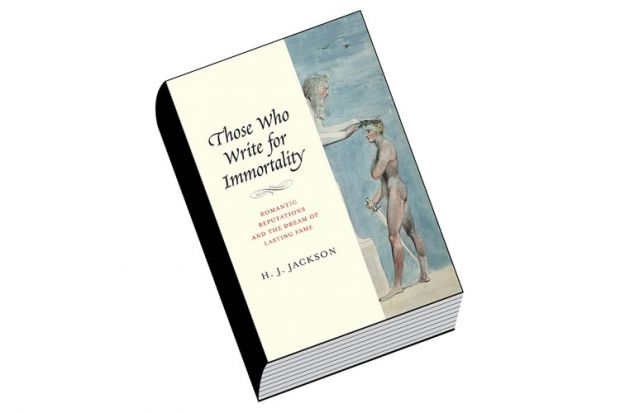As early 19th-century fictional characters go, Laura Montreville has a more exciting time of it than Elizabeth Bennet. The heroine of Mary Brunton’s 1811 best-seller Self-Control escapes abduction in Canada by faking her own death. Intrepidly tying herself into a canoe, she successfully navigates dangerous rapids and returns to England and a happy marriage. The furthest Elizabeth gets from home is Derbyshire; her watery encounter with Mr Darcy is, alas, a late 20th century invention by screenwriter Andrew Davies.
How is it, H. J. Jackson asks, that Brunton’s novel was once more popular than Pride and Prejudice? And what might this have to tell us about the nature of literary fame?
More puzzling, she suggests, is the decline in reputation of the seemingly unassailable Sir Walter Scott. Those Who Write for Immortality also asks us to consider the relative fates of Robert Southey alongside William Wordsworth; Leigh Hunt and Barry Cornwall alongside John Keats; and the posthumous rise of the stars of William Blake and John Clare.
In her extended meditation on the formation of the literary canon, Jackson acknowledges her debt to feminist scholarship for rehabilitating many of the once-successful female writers of previous centuries. William St Clair’s groundbreaking The Reading Nation in the Romantic Period (2004) is another important influence. St Clair made us question the myth that the best writing naturally survives. He exposes the network of commercial and copyright reasons for the constant reprinting of some literary works, rather than others, in the period. Lucasta Miller’s The Brontë Myth (2001) – still one of the most delightful and original works of popular literary scholarship – is another acknowledged inspiration.
Jackson proposes a new model for explaining how some authors remain perennially popular. She argues convincingly that to do so, a work has to appeal to a variety of readerships. It must lend itself to a peripheral but significant supporting industry. A place of pilgrimage (Dove Cottage and Keats House come to mind), television and film adaptations and active literary societies all contribute to enduring fame, not to mention inclusion in the school curriculum. A place in the nation’s heart helps. So does dying young. Robbie Burns, the first poet to get a memorial statue, scores well on both counts.
Jackson’s measured study is far more analytical than this makes it sound. She offers a checklist, created from quantities of data, as a tool for exploring why one author’s reputation endures where another fails. “Threshold quality” and “threshold quantity” are of primary importance. Next, the work has to have its champions beyond the lifetime of its author, who additionally needs a decent biographer. Short lyrics rather than long poems are more likely to be anthologised and therefore achieve canonisation. Despite English lecturers’ best efforts to promote The Prelude, it isn’t hard to guess which is the single Wordsworth poem most people can confidently name. As Jackson ruefully comments, “he would probably be dismayed to find on what terms he has achieved worldwide fame”.
But perhaps ultimately it all comes down to merit.
Austen, we should note, claimed she was going to take a leaf out of Brunton’s book: “I will improve upon it; – My heroine shall not only be wafted down an American river in a boat by herself, she shall cross the Atlantic in the same way, & never stop till she reaches Gravesent.”
Jane Darcy is teaching fellow in the department of English, University College London, and author of Melancholy and Literary Biography (2013).
Those Who Write for Immortality: Romantic Reputations and the Dream of Lasting Fame
By H. J. Jackson
Yale University Press, 312pp, £20.00
ISBN 9780300174793
Published 28 May 2015
Register to continue
Why register?
- Registration is free and only takes a moment
- Once registered, you can read 3 articles a month
- Sign up for our newsletter
Subscribe
Or subscribe for unlimited access to:
- Unlimited access to news, views, insights & reviews
- Digital editions
- Digital access to THE’s university and college rankings analysis
Already registered or a current subscriber? Login
